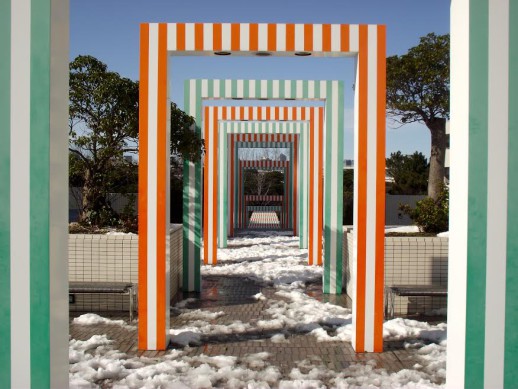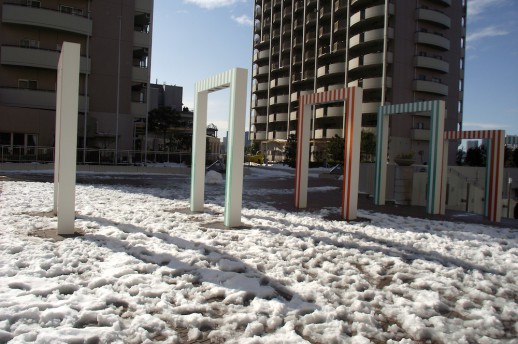Public Art #5: Daniel Buren’s “25 Porticos”

On a slope that drops down two sets of steps and stretches across two tiers before arriving at the foot of an incline is French conceptual artist Daniel Buren’s artwork 25 Porticos: The Colour and its Reflections (1996). Situated on a walkway between apartment blocks, it overlooks Tokyo Bay on the artificial island of Odaiba. Staggered at various heights, it’s composed of twenty-five striped porticos installed at regular intervals, bookended by mirrored walls at either end.
At first glance, their palette seems utilitarian—teal green, safety cone orange and hazard tape yellow—although these assumptions soon change when you realise that they reflect, in a literal sense, a local landmark. Alternating between yellow/green as you climb uphill and orange/green when walking downhill, the colours are interspersed with white vertical bands. The inner and outer edges are white too, with lights affixed beneath each crossbeam. Seen in daylight, shadows streak across the paved site, creating more lines below its vertebrae.
Each metal gateway stands at about three metres tall. They’re spaced roughly three metres apart as well but appear just beyond the reach of a possible domino effect. Of course, finding large gateways in public spaces in Tokyo is a fairly familiar sight. Although they do seem to echo a traditional torii, the gates seen at the front of shrines, Buren’s in situ installations relate more specifically to their settings. Their context determines their formation. In this case, their shape and colours reflect a landmark that can been seen from the site, one that was completed three years prior to Buren’s installation—the towers of the Rainbow Bridge across the bay.
They’re unconventional porticos, though. Ordinarily, porticos are a series of upright columns that support a roof. In this instance, the columns and their lintels bear the open air instead. Buren’s installation forms an open walkway, a corridor of door arches without walls that invites pedestrians to walk through them. They’re also like window frames or viewfinders asking to be looked through, to position viewers on a tier to see along a length of its visual interior. What prompts this is a device that Buren has been using since the mid sixties: his signature motif, the upright stripes.
Having dispensed with conventional painting, Buren first adopted this motif in 1965. Based on awnings that commonly provide shade to windows in France, he chose to appropriate a ubiquitous form, one that allows you to see by blocking out light, as well as one so familiar as to be overlooked. He refers to them as a “seeing tool”. Found at the periphery of vision, Buren draws your attention to the frame of what is seen.
The widths of the stripes don’t deviate and they are always spaced at equal intervals. What changes are the conditions where the installation occurs and it’s this that produces variation. Generally speaking, his work can be seen as an ongoing intervention with its environment, one that complicates the relationship between work and the structures that frame it. In the artist’s own words, “Architecture of any sort is the inevitable background, support and frame of any work”1.

As a contemporary artist who has dedicated his career to site-specific installations, Buren first produced public art in Tokyo in 1970. While participating in the 10th Tokyo Biennale, he contributed Affichages sauvages (1970) to Tokyo’s public art history by illegally fly posting hundreds of striped posters on subway stations throughout the city. Whether this is seen as a protest against representational art, a broadening of the institutional frame of art, or even as an act of visual colonisation, he rapidly established visual presence here, allowing him to cultivate what is now a long standing relationship with Japan.
Buren has since been prolific across the archipelago. In Tokyo alone, his work is permanently installed in Odaiba, at Shinjuku I-Land Tower and inside the offices of the Obayashi building in Shinagawa. 25 Porticos best represents his work in the city. Bright, structural and cohesive, they’re a striking example of public art on a monumental scale, a work approved for an urban site, made all the more interesting for making their first appearance in Tokyo as an unsanctioned happening.
Access: 2 minutes’ walk from Odaiba Kaihin Koen Station. Head towards Odaiba Kaihin Park. It’s above Maruetsu supermarket. 5-3, Daiba 1-Chōme, Minato, Tokyo.
Nick West
Nick West



